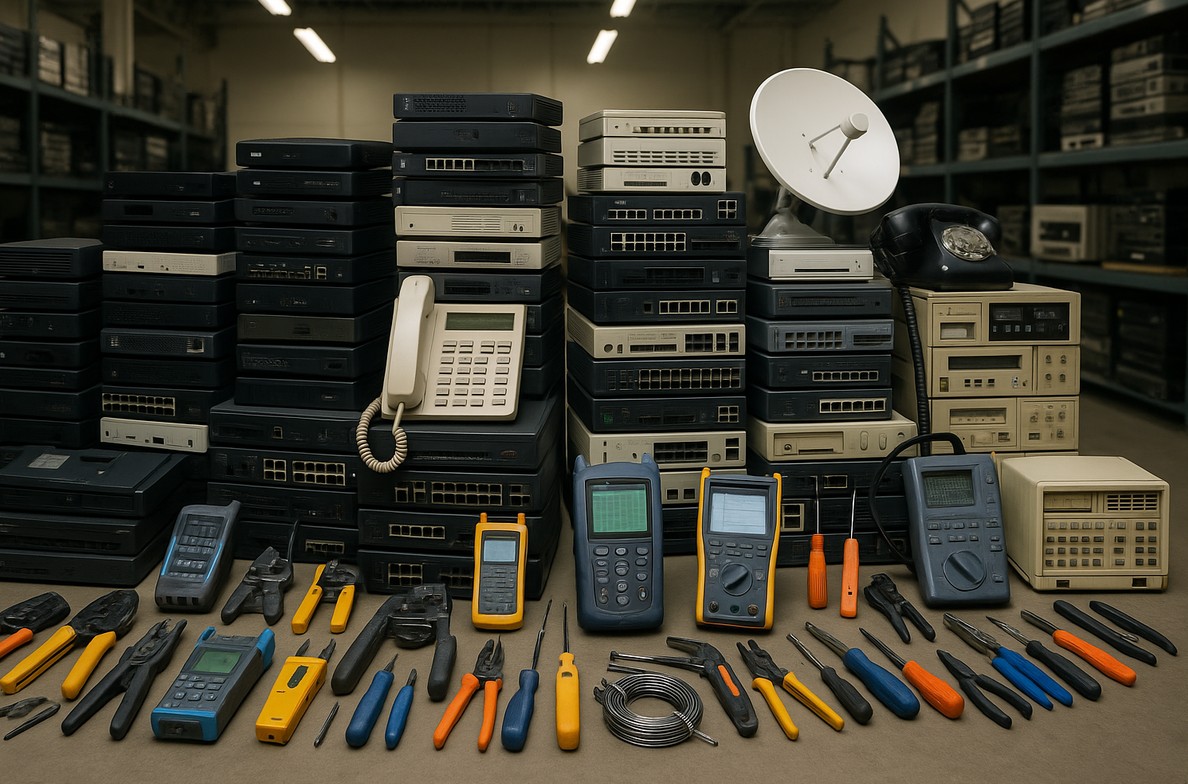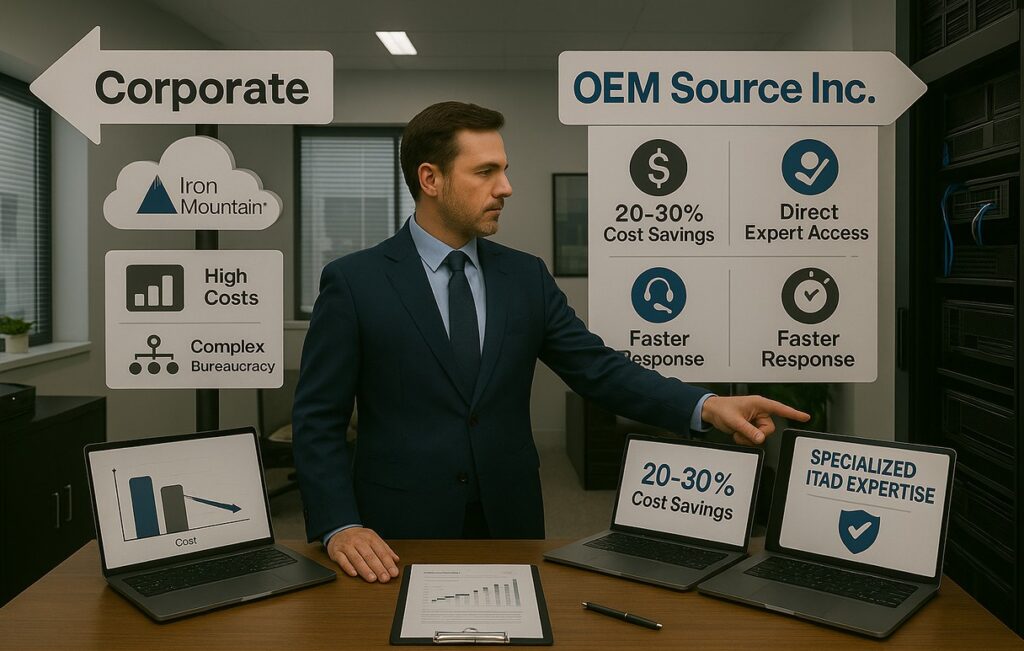Telecom infrastructure powers our connected world, but when outdated or decommissioned, it poses serious environmental and data security challenges. Each year, millions of pounds of telecom equipment like servers, routers, switches, and cables are retired, and too often improperly discarded. This leads to significant e-waste and increased risk of data breaches.
The good news? With the right recycling practices, telecom equipment can be handled responsibly, securely, and sustainably. Whether you’re an enterprise IT manager, a telecom provider, or simply managing network devices, understanding best practices for recycling and secure data destruction is more important than ever.
The Importance of Recycling Telecom Equipment
Recycling telecom equipment is about much more than getting rid of old hardware. It’s a commitment to environmental sustainability, data protection, and corporate responsibility. With telecom devices in constant evolution, end-of-life equipment is a growing challenge for businesses of all sizes.
Telecom hardware includes everything from network servers and switches to fiber optic cables. With frequent upgrades and short product lifecycles, these devices often become obsolete within just a few years. Recycling these assets ensures the safe removal of sensitive data, prevents hazardous materials from entering landfills, and allows for the recovery of valuable resources like gold, copper, and rare earth elements.
Environmental Impacts of Telecom E-Waste
Improper disposal of outdated telecom equipment poses serious environmental risks. Understanding the long-term consequences of mishandled e-waste is essential to promoting responsible recycling practices.
Electronic waste is one of the fastest-growing waste streams globally. According to the World Health Organization (WHO), more than 56.3 million metric tons of e-waste were generated in 2019, yet only 17.4% was officially documented as collected and recycled. Telecom hardware contains hazardous materials like lead and mercury, which can leach into soil and water if not disposed of properly.
Responsible recycling helps mitigate these risks by:
- Lowering the carbon footprint from new material mining
- Reducing energy use in manufacturing
- Preventing contamination from toxic substances
Safety Risks of Improper Disposal
Beyond environmental harm, improperly disposing of telecom equipment exposes businesses to serious safety hazards and legal liability.
Key dangers include:
- Data breaches: Improperly wiped devices may contain sensitive corporate or customer data.
- Hazardous materials: Lead, cadmium, and other chemicals pose health risks to employees, recyclers, and the public.
- Legal repercussions: Failure to comply with e-waste regulations can result in fines, litigation, and reputational damage.
Responsible Recycling Practices
Responsible recycling goes beyond dropping old gear at a collection site. It requires a systematic, secure, and environmentally sound process that protects both data and the environment.
Best practices include:
- Asset tracking throughout the recycling lifecycle
- Certified data destruction methods that meet industry standards
- Sustainable disposal methods through certified facilities
Always partner with certified recyclers who comply with standards like R2 (Responsible Recycling) and ISO 14001 to ensure full compliance and accountability.
Global Environmental Compliance Standards
Environmental regulations are designed to ensure that businesses handle e-waste in a way that minimizes harm. Adhering to global compliance standards isn’t optional—it’s essential.
Key environmental regulations include:
- WEEE Directive (EU): Requires recovery and recycling of electrical and electronic equipment.
- EPA Universal Waste Rule (U.S.): Outlines standards for proper handling of hazardous electronic waste.
- GDPR (EU): Mandates secure handling and irreversible destruction of personal data during device disposal.
Secure Data Destruction Methods
Secure data destruction is a critical step before disposing of any telecom equipment. The risk of data breaches doesn’t end when the hardware stops functioning.
Before recycling, telecom equipment must undergo one or more of the following secure data destruction methods:
- Data wiping using certified software
- Degaussing for magnetic storage media
- Physical destruction, such as shredding hard drives
Always confirm your recycler partner provides Certificates of Data Destruction to support compliance and audit readiness.
Initiatives for Effective Telecom Recycling
There are a variety of initiatives that simplify the process of telecom recycling. These programs help bridge the gap between equipment disposal and environmental responsibility.
Selling and Trade-In Programs
Many vendors offer trade-in credit or direct resale value for used telecom assets. This supports asset recovery and offsets new equipment.
Research estimates that only 25% of electronics are properly recycled, making resale a valuable and underutilized strategy.
These programs help businesses:
- Extract the remaining value
- Reduce electronic waste
- Streamline the end-of-life disposal workflows
Take-Back Programs
Some manufacturers and service providers run take-back programs, accepting used equipment for responsible recycling. These programs help reduce liability and environmental impact, while supporting resource recovery.
Benefits include:
- Logistical support for collection and return
- Clear compliance guidelines
- Resource recovery and reduced liability
Take-back programs are particularly effective for businesses managing large volumes of network equipment across multiple sites.
Industry Leaders in Telecom Equipment Recycling
Industry leaders in telecom recycling provide certified services, transparent processes, and eco-friendly outcomes. Partnering with these organizations ensures regulatory compliance, data protection, and streamlined operations.
Sadoff and SunCoast Solutions
These providers specialize in IT asset recovery and certified e-waste recycling, helping businesses meet both environmental and regulatory standards.
- Offer secure recycling and data destruction services
- Focus on simplifying the recycling process
- Help clients meet sustainability goals while protecting sensitive information
ChiComm Innovations
ChiComms delivers telecom recycling services tailored for complex computing and fiber optic networks, focusing on sustainability and secure disposal.
- Known for their customized approach to intricate infrastructure
- Ideal for enterprises with large-scale or legacy telecom systems
We Buy Used IT Equipment
This provider focuses on equipment evaluation and maximum value recovery for network equipment, with expertise in secure data destruction and resale.
- Supports fast inventory audits, logistics coordination, and hardware resale
- Helps businesses monetize decommissioned equipment while ensuring secure disposition
Benefits of Recycling Telecom Equipment
The benefits of responsible telecom recycling extend far beyond regulatory compliance. Enterprises can realize real economic savings and environmental impact reductions.
Resource Conservation
Recovering valuable materials like gold, copper, and palladium from decommissioned devices helps reduce the demand for raw material extraction.
This practice conserves natural resources and supports a circular economy by reintegrating recovered materials into new products.
Cost Savings
Through investment recovery services and resale, businesses can recoup residual value from old hardware while minimizing disposal costs.
In many cases, these savings can significantly offset the investment in new infrastructure.
Reducing the Environmental Impact of Outdated Telecom Hardware
Outdated telecom equipment often contains hazardous materials that pose environmental risks if not recycled properly. Certified recycling partners ensure safe handling and reduce the burden on landfills.
By working with reliable recycling partners, businesses not only reduce their environmental footprint but also reinforce their commitment to corporate sustainability, enhancing their public image and stakeholder trust.
Best Practices for Choosing a Recycling Program
Choosing the right recycling partner is critical. Not all recycling programs are created equal.
Key Considerations in Selection
When selecting a telecom recycling partner, look for:
- Certifications such as R2, ISO, or NAID
- Verified data destruction protocols and guarantees
- Comprehensive chain-of-custody documentation
- A strong sustainability track record
Evaluating these factors ensures you’re partnering with a qualified provider who prioritizes safety and environmental responsibility.
Achieving Sustainability Goals through Telecom Recycling
Telecom recycling isn’t just a technical necessity it’s a strategic lever for achieving broader sustainability and ESG objectives.
Aligning with Eco-Friendly Practices
Recycling supports corporate sustainability commitments. According to RTS, 40% of millennials consider a company’s environmental commitment when job hunting
This makes responsible recycling a valuable component of your employer brand and corporate identity.
Embracing a Comprehensive Approach to Disposal
A complete program should include:
- Inventory auditing and lifecycle assessments
- Data center and network equipment recycling
- Logistics coordination and secure transport
- Transparent environmental impact reporting
By embedding telecom recycling into your broader IT and sustainability strategies, you position your company for long-term success environmentally, financially, and reputationally.
Turn Telecom Waste into Strategic Value
Recycling telecom equipment isn’t just good for the planet—it’s good for your business. From reducing environmental impact to ensuring data security and achieving sustainability goals, the benefits are clear.
Ready to upgrade your telecom recycling strategy? Partner with OEM Source for secure, compliant, and sustainable asset recovery. Our industry-certified solutions help you minimize risk, maximize value, and align with ESG commitments without the guesswork.
Frequently Asked Questions
Why is secure data destruction important before recycling telecom equipment?
Secure data destruction prevents data breaches and ensures compliance with regulations like GDPR. Devices that aren’t properly wiped can expose sensitive corporate or customer information, leading to serious legal and financial consequences.
What are the best ways to recycle telecom hardware?
Partner with certified recyclers that offer secure data destruction, asset recovery services, and environmental compliance. Look for partners with companies with R2 or ISO certifications.
Can old telecom equipment be resold?
Yes. Through investment recovery and resale programs, functioning telecom gear can be refurbished and reused. This supports sustainability initiatives while helping businesses recoup value and offset upgrade costs..
How can recycling telecom gear help meet ESG goals?
Recycling supports environmental responsibility, reduces your carbon footprint, and ensures ethical disposal of electronic waste. These practices contribute directly to ESG reporting metrics and sustainability targets..
What telecom equipment can typically be recycled?
Most network infrastructure and end-user devices can be recycled, including routers, switches, servers, cabling, and power supplies. Even outdated fiber optics and backup batteries can be processed through certified recyclers for safe material recovery.





